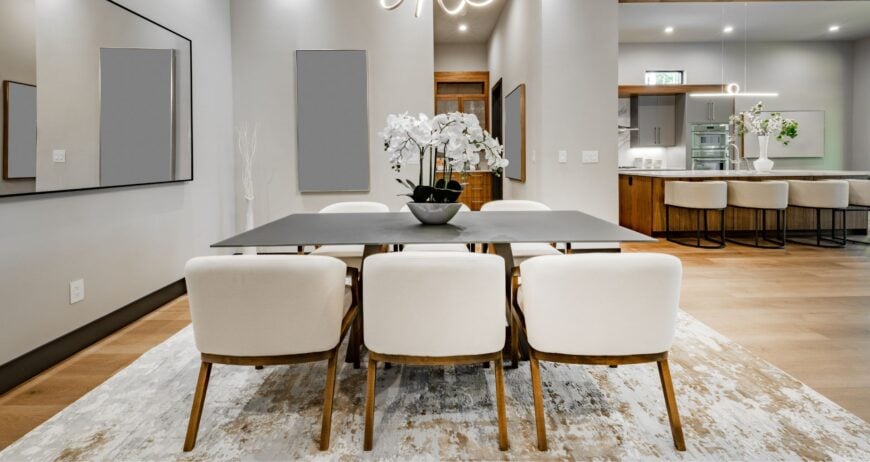
Ever wonder why some dining rooms buzz with conversation while others feel stiff and formal? The shape of your table might be the hidden factor you’ve never considered.
The Psychology That Makes Round Tables Work

The science behind round tables fascinates me. It goes way deeper than just aesthetics or tradition. When researchers study how people interact around different table shapes, round tables consistently create more engaging conversations.
In order to come up with the very specific design ideas, we create most designs with the assistance of state-of-the-art AI interior design software.
Here’s what’s happening: Round tables eliminate the power position. There’s no head of the table where someone automatically takes charge. Instead, everyone sits as an equal. Environmental psychologists call this “sociopetal space” – a fancy term for design that naturally brings people together.
But it’s not just about equality. Round tables solve practical communication problems too. Everyone can see each other without awkward neck-craning. The speaking distance stays consistent. No one ends up shouting across a long rectangle trying to join the conversation.
Cultural Wisdom Behind Circular Dining
The Chinese figured this out centuries ago during the Qing dynasty. They shifted from traditional rectangular tables to round ones as society became more egalitarian. That’s why Chinese restaurants still use round tables with Lazy Susans – it’s not just about passing food easily. It’s about creating natural conversation flow.
Getting The Size Right Matters More Than You Think
Size can make or break a round table’s effectiveness. Too small and everyone’s cramped. Too large and you lose the intimacy that makes round tables special.
For intimate dinner parties and family meals:
- 36-40 inch diameter works perfectly for 4 people
- 48 inches gives comfortable space for 6
- 60 inches handles 8 while keeping conversation natural
Beyond that size, you start losing the benefits. People have to raise their voices to be heard across the table, which defeats the purpose of choosing round in the first place.
Round 4-Seater

Round 6-Seater

Square 6-Seater

Square 8-Seater

Rectangle 6-Seater

Rectangle 8-Seater

The Base Design Changes Everything
The pedestal versus four legs debate matters more than most people realize. A pedestal base transforms how people use the space around a round table. It gives you:
- Maximum legroom without awkward table legs to dodge
- Flexibility to squeeze in an extra chair when needed
- Easier movement around the table
- A more open feel in smaller spaces
Smart Space Planning Makes The Difference
Getting the spacing right transforms how people use your dining room. You need:
- At least 36 inches between table edge and walls
- 42-48 inches if you want extra comfort
- 10-12 inches from chair seat to table height for comfortable dining
These measurements aren’t just random numbers. They’re based on decades of interior design experience and research into how people naturally move and interact in dining spaces.
When Round Tables Aren’t The Answer

Let’s be real – round tables aren’t perfect for every situation. Sometimes rectangular makes more sense, especially for:
- Large formal dinners where you’re seating lots of people
- Narrow rooms where space is at a premium
- Teaching situations where someone needs to lead
- Buffet-style service where food line flow matters
Choosing Materials That Create The Right Vibe
The material of your table shapes the entire dining experience:
- Wood brings natural warmth and encourages longer, more relaxed meals
- Glass creates a modern feel and makes small spaces feel bigger
- Marble adds elegance but can feel cold and formal
- Stone looks stunning but requires careful space planning due to weight
Making Round Tables Work In Modern Homes
Interior designers increasingly recommend round tables for modern homes because they suit today’s more casual, connected lifestyle. They create natural gathering spots that encourage lingering conversations over coffee or wine.
The key is matching the table to how you actually live. If you host regular family dinners or small gatherings where conversation matters, round tables shine. They naturally encourage everyone to engage, share stories, and connect.
The Future of Dining Room Design
As homes become more focused on creating genuine connection, round tables are seeing a renaissance. Designers are finding innovative ways to incorporate their benefits into modern spaces:
- Expandable round tables that convert to oval for larger groups
- Mixed material designs that combine warmth and durability
- Smart sizing that maximizes small space potential
The trend toward round tables reflects a broader shift in how we think about home design – moving away from formal, rigid spaces toward rooms that naturally encourage interaction and conversation.
Sources
- Falout, J. (2014). Circular seating arrangements: Approaching the social crux in language classrooms. Studies in Second Language Learning and Teaching
- Bae, K. (2019). Round Tables in China: How Round Tables Made Their Way into Chinese Dining Halls. Making Modernity in East Asia – Technologies of Everyday Life, HKU.
https://hub.hku.hk/handle/10722/289544 - POVISON Blog. Creating Intimacy with Round Dining Tables: Perfect for Family Meals.
- Castle Custom Homes Blog. Encouraging Conversation Through Design.
- BUILD Magazine. Crafting Communal Spaces: The Role of Dining Tables in Modern Homes.
- Cantoni Blog. 5 Dining Room Design Tips to Make Room for Guests.
- Castlery Blog. 8 Key Dining Table Measurements You Should Know About.






